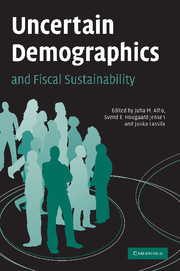Book contents
- Frontmatter
- Contents
- List of figures
- List of tables
- List of contributors
- Preface
- 1 Introduction
- Part I Uncertain demographics
- 2 Changing views of future demographic trends
- 3 Empirically based specification of forecast uncertainty
- Comment: The UPE forecasts: strengths, innovations, developments
- Part II Measuring sustainability in a stochastic environment
- Part III Enhancing sustainability
- Part IV Extensions
- Index
- References
3 - Empirically based specification of forecast uncertainty
Published online by Cambridge University Press: 22 September 2009
- Frontmatter
- Contents
- List of figures
- List of tables
- List of contributors
- Preface
- 1 Introduction
- Part I Uncertain demographics
- 2 Changing views of future demographic trends
- 3 Empirically based specification of forecast uncertainty
- Comment: The UPE forecasts: strengths, innovations, developments
- Part II Measuring sustainability in a stochastic environment
- Part III Enhancing sustainability
- Part IV Extensions
- Index
- References
Summary
Introduction
To make a conventional population forecast one needs to specify age-specific fertility rates for women, and mortality rates for women and men, for all future years of interest. These are used to generate births and deaths. The simplest way to handle migration is to specify net migration in absolute numbers that are added to population each year. Starting from a jump-off population, the so-called cohort-component bookkeeping (e.g. Shryock, Siegel and associates, 1976) is used recursively to keep track of the resulting changes in population, by age and sex. These methods were first used by Cannan (1895) for England and Wales, and since the 1920s and 1930s they have been widely used in Europe (DeGans, 1999). The early forecasters were aware that calculations based on the cohort-component method are only as reliable as the assumptions that go into making them. Alternative variants were offered from early on, but even the forecast producers themselves were uneasy about the methods that were used to prepare them (e.g. Modeen, 1934).
Stochastic (or probabilistic) cohort-component forecasts are similar, but in this case future fertility and mortality rates and net migration are considered as random variables (e.g. Alho and Spencer, 2005). Their distributions can be specified in various ways. Perhaps the simplest is to give first the location of the distribution, and then to specify the spread (or scale) around it to reflect forecast uncertainty.
- Type
- Chapter
- Information
- Uncertain Demographics and Fiscal Sustainability , pp. 34 - 54Publisher: Cambridge University PressPrint publication year: 2008
References
- 11
- Cited by



